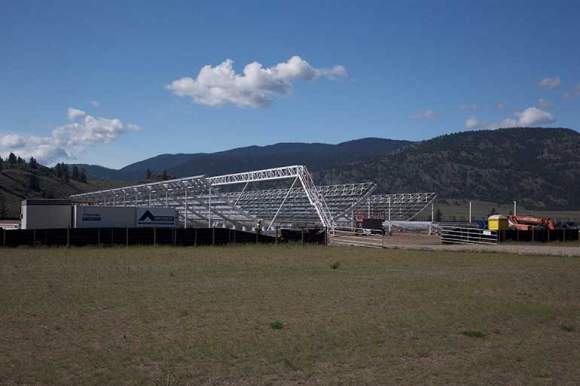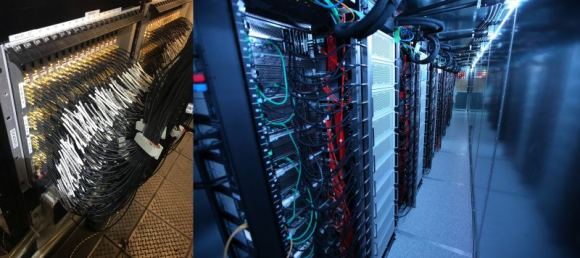


The CHIME Telescope, located at the Dominion Radio Astrophysical Observatory (DRAO), in British Columbia. Credit:

According to a new study, FRBs could be energetic outbursts caused by the collapse of crusts around "strange stars". Credit: NASA/Goddard Space Flight Center

This artist’s impression of the cosmic web, the filamentary structure that fills the entire Universe, showing radio sources associated with FRBs. Credit: M. Weiss/CfA
Here's a big mystery in astronomy: fast radio bursts. Brief shrieks of radio waves coming from space. What are they? Where do they come from? Astronomers have no idea. Sign up to my weekly email newsletter: Support us at:Support us at: : More stories at Follow us on Twitter: @universetoday Like us on Facebook: Google+ - Instagram - Team: Fraser Cain - @fcain / frasercain@gmail.com /Karla Thompson - @karlaii Chad Weber - Chloe Cain - Instagram: @chloegwen2001 You might think you’re watching an educational channel, where I explain fascinating concepts in space and astronomy, but that’s not really what’s going on here. What’s actually happening is that you’re tagging along as I learn more and more about new and cool things happening in the Universe. I dig into them like a badger hiding a cow carcass, and we all get to enjoy the cache of knowledge I uncover. Okay, that analogy got a little weird. Anyway, my point is. Squirrel! Fast radio bursts are the new cosmic whatzits confusing and baffling astronomers, and now we get to take a front seat and watch them move through all stages of process of discovery. Stage 1: A strange new anomaly is discovered that doesn’t fit any current model of the cosmos. For example, strange Boyajian’s Star. You know, that star that probably doesn’t have an alien megastructure orbiting around it, but astronomers can’t rule that out just yet? Stage 2: Astronomers struggle to find other examples of this thing. They pitch ideas for new missions and scientific instruments. No idea is too crazy, until it’s proven to be too crazy. Examples include dark matter, dark energy, and that idea that we’re living in a Stage 3: Astronomers develop a model for the thing, find evidence that matches their predictions, and vast majority of the astronomical community comes to a consensus on what this thing is. Like quasars and gamma ray bursts. YouTuber’s make their videos. Textbooks are updated. Balance is restored. Today we’re going to talk about Fast Radio Bursts. They just moved from Stage 1 to Stage 2. Let’s dig in. Fast radio bursts, or FRBs, or “Furbys” were first detected in 2007 by the astronomer Duncan Lorimer from West Virginia University. He was looking through an archive of pulsar observations. Pulsars, of course, are newly formed neutron stars, the remnants left over from supernova explosions. They spin rapidly, blasting out twin beams of radiation. Some can spin hundreds of times a second, so precisely you could set your watch to them. In this data, Lorimer made a “that’s funny” observation, when he noticed one blast of radio waves that squealed for 5 milliseconds and then it was gone. It didn’t match any other observation or prediction of what should be out there, so astronomers set out to find more of them. Over the last 10 years, astronomers have found about 25 more examples of Fast Radio Bursts. Each one only lasts a few milliseconds, and then fades away forever. A one time event that can appear anywhere in the sky and only last for a couple milliseconds and never repeats is not an astronomer’s favorite target of study. Actually, one FRB has been found to repeat, maybe. The question, of course, is “what are they?”. And the answer, right now is, “astronomers have no idea.” In fact, until very recently, astronomers weren’t ever certain they were coming from space at all. We’re surrounded by radio signals all the time, so a terrestrial source of fast radio bursts seems totally logical. About a week ago, astronomers from Australia announced that FRBs are definitely coming from outside the Earth. They used the Molonglo Observatory Synthesis Telescope (or MOST) in Canberra to gather data on a large patch of sky. Then they sifted through 1,000 terabytes of data and found just 3 fast radio bursts. Three. Since MOST is farsighted and can’t perceive any radio signals closer than 10,000 km away, the signals had to be coming outside planet Earth. They were “extraterrestrial” in origin. Right now, fast radio bursts are infuriating to astronomers. They don’t seem to match up with any other events we can see. They’re not the afterglow of a supernova, or tied in some way to gamma ray bursts. In order to really figure out what’s going on, astronomers need new tools, and there’s a perfect instrument coming. Astronomers are building a new telescope called the Canadian Hydrogen Intensity Mapping Experiment (or CHIME), which is under construction near the town of Penticton in my own British Columbia.
As they stated in the Astronomers Telegram announcement, the radio was signal was detected on July 25th, at precisely 17:59:43.115 UTC (09:59.43.115 PST), and at a radio frequency of 400 MHz: “The automated pipeline triggered the recording to disk of ~20 seconds of buffered raw intensity data around the time of the FRB. The event had an approximate width of 2 ms and was found at dispersion measure 716.6 pc/cm^3 with a signal-to-noise ratio S/N ~20.6 in one beam and 19.4 in a neighboring beam. The centers of these, approximately 0.5 deg wide and circular beams, were at RA, Dec = (06:13:54.7, +67:04:00.1; J2000) and RA, Dec = (06:12:53.1, +67:03:59.1; J2000).”
Canada’s largest radio telescope begins to map the universe
Canadian Telescope Finds 13 More Fast Radio Bursts Including the Second One Ever Seen Repeating

The novel CHIME telescope is a product of a collaboration between 50 Canadian scientists. Photo Courtesty of ANDRE RENARD. DUNLAP INSTITUTE FOR ASTRONOMY AND ASTROPHYSICS September 7, 2017 marked an important day for an all-Canadian collaboration of astronomers and astrophysicists from the University of Toronto, the University of British Columbia, McGill University, and the National Research Council of Canada. After many years of development, the Canadian Hydrogen Intensity Mapping Experiment (CHIME) began collecting data in an effort to create the largest map of the universe to date. webpage

CHIME is situated in a valley in the Okanagan region of BC. The surrounding mountains provide a “radio-quiet” setting where stray terrestrial radio signals are kept to a minimum. The setting helps CHUME detect fast radio bursts. Image Credit: CHIME Observatory.

A two-stage super-computer helps CHIME detect fast radio bursts. On the left is the F-Engine, which digitized each radio signal 800 million times per second. The F-Engine processes incoming data at the rate of 13 Terabits per second. (!!!) On the right is the X-Engine. It receives the digital data from the F-Engine and processes. The X-Engine creates “correlation matrices” every few seconds, which are then processed into sky maps. Image Credit: CHIME.
Animation illustrating the random appearance of Fast Radio Bursts on the sky. from NRAO Outreach on Vimeo.

Another view of CHIME’s four “half-pipes” and 1024 receivers. The telescope has no moving parts and observes the entire northern sky as it passes overhead. No fast radio burst can escape detection! Image: CHIME.

Located in the Okanagan Valley outside of Penticton, British Columbia, there is a massive radio observatory dedicated to observing cosmic radio phenomena. It’s called the Canadian Hydrogen Intensity Mapping Experiment (CHIME), a cylindrical parabolic radio telescope that looks like what snowboarders would call a “half-pipe.” This array is part of the Dominion Radio Astrophysical Observatory (DRAO), overseen by the National Research Council (NRC)(Canada).
<>
Here's a big mystery in astronomy: fast radio bursts. Brief shrieks of radio waves coming from space. What are they? Where do they come from? Astronomers have no idea. Sponsored by the .space domain name. Go to and use the code "GUIDETOSPACE" to get a domain for $2.99. Follow us on Twitter: @universetoday Like us on Facebook: Instagram - Support us at:Support us at: Instagram - Team: Fraser Cain - @fcain / frasercain@gmail.com /Karla Thompson - @karlaii Chad Weber - Chloe Cain - Instagram: @chloegwen2001 Music: Left Spine Down - “X-Ray” Team: Fraser Cain - @fcain / frasercain@gmail.com Karla Thompson - @karlaii / Karla Thompson's youtube channel Chad Weber - weber.chad@gmail.com
<>
00:00 Title Slide (slide 1) 00:23 Outline (slide 2) 00:01 Section: Overview (slide 3) 01:33 CHIME/FRB VOEvent Service Modules (slide 5) 02:14 Section: Subscriptions and Alert Handling (slide 7) 03:14 Subscription Requirement: Email Address (slide 9) 03:56 Subscription Requirement: Name (slide 10) 04:10 Subscription Requirement: Affiliation (slide 11) 04:35 Subscription Requirement: IP Address (slide 12) 05:17 Subscription Requirement: XML Flag (slide 13) 05:31 Subscription Requirement: Email Flag (slide 14) 05:55 Steps to Receive XML Using Comet Broker (slide 15) 06:52 Steps to Receive Email (slide 16) 08:31 Jupyter Notebook Tutorial for Parsing VOEvents (slide 18) 09:00 Section: Real-time Alerts (slide 19) 11:35 Criteria for Event Detection and VOEvent Alerts (slide 23) 13:10 VOEvent XML Section (slide 25) 13:37 "Who" XML Section (slide 26) 14:11 "What" XML Section (slide 27) 15:37 DM and Event Number Meta Data Explanation (slide 30) 16:37 Event Type Meta Data Explanation (slide 31) 17:19 Known Source Name Meta Data Explanation (slide 32) 18:04 Localization Uncertainty Meta Data Explanation (slide 33) 20:28 "WhereWhen" XML Section (slide 37) 20:59 "How" XML Section (slide 38) 21:27 "Why" XML Section (slide 39) 22:44 "Citations" XML Section (slide 40) 23:47 Section: Thresholds, Data Quality, and Performance (slide 41) 24:30 Selecting Thresholds (Table 1) (slide 42) 25:42 Recommended SNR Thresholds (Table 2) (slide 43) 27:12 Alert Latency (Table 3) (slide 44) 28:33 Data Quality (slide 46) 29:52 Limitations and Provisos of Real-time VOEvents (slide 48) 31:59 Real-time Localization Challenges (Figure 4) (slide 50) 33:24 Service Outages and Downtime (slide 52) 34:07 Section: Post Real-time Alerts (slide 53) 34:43 Retraction of VOEvents (slide 55) 35:50 Update of VOEvents (slide 56) 36:32 Section: Conclusion (slide 57) 37:37 CHIME/FRB Collaboration Institution Credits (slide 59) 38:18 References (slide 60) Notes: 1. The Microsoft Form subscription form has been replaced with an online webform hosted at chime-frb.ca. 2. Subscribing to the email version of the VOEvents will add your specified email address to a Google Group called CHIME/FRB VOEvent Service. Emails of VOEvents and other news will be sent to you from chimefrb-voevent-service@googlegroups.com. 3. The Jupyter notebook tutorial for handling CHIME/FRB VOEvents is available on our GitHub IO page